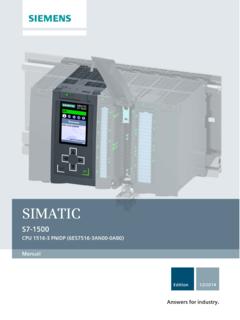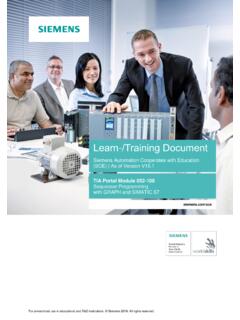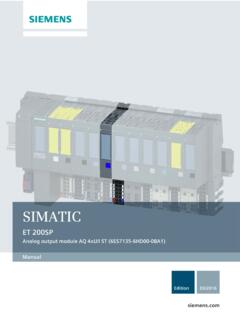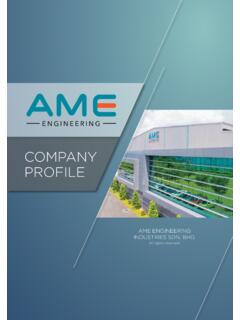Transcription of Basics of PLCs - SITRAIN LMS
1 Siemens Industry, of PLCsA quickSTEP Online Course Siemens Industry, Inc. 2016 TrademarksSiemens and SIMATIC are trademarks of Siemens AG. Other trademarks are the property of their respective 1-2 Siemens Industry, Inc. 2016 Course TopicsWelcome to Basics of PLCs. This course covers the following topics:Chapter 1 - Introduction Overview Basic ConceptsChapter 2 - S7-1200 PLCs S7-1200 PLC Overview S7-1200 with Safety IntegratedChapter 3 - S7-1200 PLC Programming Programming Concepts LAD Programming Basics LAD Timers and CountersChapter 4 - Additional Information Additional S7-1200 Capabilities Additional ProductsIf you do not have an understanding of basic electrical concepts, you should complete Basics of Electricity before attempting this 1-3 Siemens Industry, Inc.
2 2016 Course ObjectivesUpon completion of this course you will be able Describe important number systems and data types used by Siemens PLCs. Identify the major components of a PLC and describe their functions. Describe the parts of a typical PLC scan. Define the terms functional safety and failsafe. Identify the key features of S7-1200 standard and failsafe CPU models. Identify the types of S7-1200 PLC signal and communication modules. Summarize the capabilities of TIA Portal. Summarize the capabilities of STEP 7 (TIA Portal). Describe what is meant by security integrated . List the programming languages available for S7-1200 PLCs.
3 Describe the concept of modular programming and the types of program and data blocks available for Siemens PLCs. Describe the operation of the most commonly used ladder diagram programming instructions. Describe what is meant by S7-1200 integrated 1-4 Siemens Industry, Inc. 2016 SIMATIC S7-1200 PLCsAutomation solutions must be compact, scalable, and flexible. Siemens SIMATIC S7-1200 PLCs are available as standard and failsafe versions. In addition to helping you learn basic PLC concepts, this course will help you understand the capabilities of S7-1200 PLCs, which can be optimally adapted to your individual requirements with pluggable signal and communication boards and 1-5 Siemens Industry, Inc.
4 2016 SITRAIN Training for IndustryPage 1-6 Online Self-paced Learning Programs with maximum flexibility so students can easily fit courses into their busy schedulesVirtual Instructor-led Learning - Classroom lectures delivered in the convenience of your home or officeClassroom Learning - Expert and professional instructors, proven courseware, and quality workstations combine for the most effective classroom experience possible at your facility or oursHow-to Video Library - Quick, affordable, task-based learning options for a broad range of automation topics for training or purchaseSimulators - World-class simulation systems available for training or purchaseThis course also describes learning options available from the Siemens SITRAIN USA organization and our global SITRAIN partners.
5 For additional information: Siemens Industry, Inc. 2016 Chapter 1 - IntroductionThis chapter covers the following topics: Overview Basic ConceptsPage 1-7 Siemens Industry, Inc. 2016 DefinitionA programmable logic controller (PLC), also referred to as a programmable controller, is a type of computer commonly used in commercial and industrial control differ from office computers in the types of tasks they perform and the hardware and software they require to perform these tasks. While the specific applications vary widely, all PLCs monitor inputs and other variable values, make decisions based on a stored program, and control outputs to automate a machine or are many types of PLCs, and they vary significantly in appearance and capabilities.
6 Therefore, to keep this course simple, the examples used focus primarily on Siemens SIMATIC S7-1200 basic controllers. Although S7 1200 PLCs offer basic automation solutions, they also have many advanced features, and learning about S7-1200 PLCs will help you gain a good understanding of PLC 1-8 Siemens Industry, Inc. 2016 Basic PLC OperationThe basic components of a PLC include input signal modules, a central processing unit (CPU), output signal modules, and a programming device. The types of input and output signal modules used by a PLC depend upon the types of input and output devices used. Input signal modules convert the signals provided by input devices into logic signals that can be used by the CPU uses the values of inputs, outputs, and other variables as it executes the user program stored in its memory.
7 The CPU then sends signals to update the statuses of outputs. Output signal modules convert signals from the CPU into digital or analog signals that can be used to control output programming device is used to enter or change the PLC s program and to monitor or change stored values. Once entered, the program and associated variables are stored in the control system may also incorporate one or more human machine interfaces (HMIs) to monitor and control a machine or process. HMIs are not PLC components, but work closely with the 1-9 Siemens Industry, Inc. 2016 Simple ExampleIn this simple example, pushbuttons connected to PLC inputs are used to start and stop a motor connected to a PLC output through a motor programming device is shown in this example because, once the PLC has been programmed, the PLC can perform its control tasks without the programming , an HMI is not shown, because this is a simple control example.
8 However, additional outputs from the PLC may control indicator lights that show whether the motor is stopped or running or indicate a fault, such as a motor 1-10 Siemens Industry, Inc. 2016 Hard-Wired ControlPrior to PLCs, control tasks were often performed by contactors, control relays, and other electromechanical devices with intricate interconnecting wires. This approach is often referred to as hard-wired hard-wired control solutions are capable of performing some of the same tasks as PLCs, hard-wired control is generally more difficult to design, install, and maintain. In addition, the process of making even simple modifications to a hard-wired control solution can be difficult because the logic of the control system is determined by the interconnection of control wires and 1-11 Siemens Industry, Inc.
9 2016 Advantages of PLCsSome of the advantages of PLCs when compared to hard-wired solutions are as follows: PLCs can perform more complex control tasks PLCs can communicate with other systems PLC systems are more reliable PLC systems can be more easily and more effectively documented PLC systems are easier to operate and maintain PLC system changes are easer to implement PLC applications can be duplicated faster and less expensivelyPage 1-12 Siemens Industry, Inc. 2016 SIMATIC ProductsSiemens SIMATIC products are the foundation upon which our totally integrated automation (TIA) concept is based. Because the needs of end users and machine builders vary widely, the SIMATIC family includes a wide range of controllers, human machine interfaces (HMIs), and related products.
10 For example, SIMATIC PLCs are available as conventional modular controllers, embedded automation products, and as PC-based SIMATIC S7 PLCs are optimized for control tasks and can be adapted to meet application requirements using plug-in modules for input/output (I/O), special functions, and communications. Examples of products in this category include: S7-1200 basic controllers, ET 200SP distributed controllers, and S7-1500 advanced controllers. The focus of this course is on S7-1200 basic 1-13 Siemens Industry, Inc. 2016 Online Self-paced LearningWith Siemens online self-paced learning, students select the topics and set their own pace for completing chosen courses.







